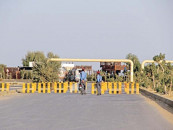Malaria outbreak grips Sindh
Over 22,000 malaria cases reported as garbage, sewage, and stagnant wastewater fuel spawning

The province is grappling with a severe mosquito infestation, fueled by garbage accumulation, overflowing sewage, and a poorly maintained drainage system.
The intense heat and frequent power outages have further worsened the living conditions for residents. As a result, hundreds of people are being infected with malaria daily, while local authorities remain reluctant to carry out germ-killing spray operations in streets and neighbourhoods.
Sindh Health Department Vector-Borne Diseases Director of Dr Mushtaq Ahmed Shah warned that malaria is a serious and potentially fatal disease transmitted by the bite of an infected female Anopheles mosquito, which typically breeds in stagnant water and unsanitary conditions. Symptoms of malaria include recurring high fever, severe fatigue, chills, muscle and joint pain, headache, nausea, and vomiting. In some cases, patients also experience diarrhea and abdominal pain, which can worsen their condition. The disease often intensifies at night, causing significant discomfort and disrupting sleep.
In Sindh, malaria cases have now surpassed 22,000. Diagnosis is typically made using one of three common tests - the Malaria ICT (Immunochromatographic Test), Malaria Smear, and Malaria PCR (Polymerase Chain Reaction). The disease poses a heightened risk to vulnerable populations, especially children and pregnant women.
Dr Shah has urged the public to adopt preventive measures to reduce the risk of infection. These include sleeping under mosquito nets, wearing full-sleeved clothing, applying mosquito repellent to exposed skin, eliminating stagnant water in and around homes, and maintaining general cleanliness. He also emphasised the importance of seeking immediate medical attention if malaria symptoms appear.
According to a recent report released by the Directorate General of Health Services, part of the Sindh Health Department, malaria cases have surged significantly in 2025. From January one to April 20, a total of 22,358 cases have been reported. The Larkana Division has been the worst affected, with 7,392 cases, while, Hyderabad has reported 8,476 cases, Sukkur - 2,030 cases, Mirpurkhas - 1,498 cases, Shaheed Benazirabad - 2,756 cases, and Karachi - 206 cases.
The report also provides a breakdown of malaria types among patients: 16,906 cases of Plasmodium vivax (PV), 4,820 cases of Plasmodium falciparum (PF), and 632 cases involving mixed infections. Despite the high number of infections, only one patient developed cerebral malaria and required hospitalisation. Fortunately, there have been no reported malaria-related deaths in the province to date.
Meanwhile, public concern continues to grow over the increasing mosquito activity, particularly in the evening hours. Power outages, combined with stifling heat, have created ideal conditions for mosquito attacks. With rooms becoming hot and humid, residents report being bitten relentlessly, disrupting rest and placing children at particular risk. Although many households are using insecticides indoors, there is growing frustration over the persistent influx of mosquitoes from outside, and the lack of government-sponsored fumigation efforts in public areas.



















COMMENTS
Comments are moderated and generally will be posted if they are on-topic and not abusive.
For more information, please see our Comments FAQ